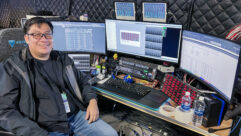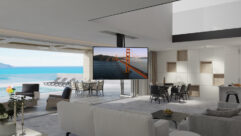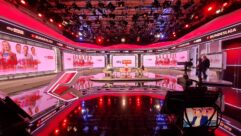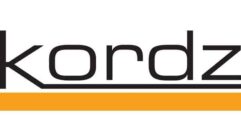
Installation Profile: Memphis Belle
Jul 1, 2004 12:00 PM,
By Charles Conte
The collaboration space is for students to meet or relax between classes.
It’s being called the digital research epicenter of the mid-South, a reference to its location on the seismic fault line that runs through Memphis. While the FedEx Institute of Technology at the University of Memphis may not be an earth-shattering concept, it certainly has shaken up any notions that keep separate the corporate and educational research environments.
The FedEx Institute of Technology is the first school of its kind to adopt a major corporate name. It’s a $23 million public-private collaboration between the University of Memphis and local shipping giant FedEx Corp., established to advance world-class interdisciplinary research and introduce a new generation of highly skilled graduates to the workforce. FedEx invested $5 million in the project, with the remainder coming from city, county, and state governments.
The University of Memphis, with its corporate research partners, aims to become the mid-South’s leading research university, bringing focus to its existing research portfolio and national attention to the region’s technological and research resources. Researchers from across campus have access to the latest high-tech tools and the opportunity to interact with researchers from other universities. At the same time, the institute is an evolving, dynamic resource for businesses at large, a forum through which they can collaborate with researchers to find solutions to real-world problems.
The 95,000-square-foot building incorporates a wireless fidelity network, a voice-over Internet protocol network, interactive multimedia theaters for meetings and presentations, computer labs, training rooms, collaboration areas, an exhibit area, and labs. The facility uses the latest technologies and tools in a very human space to teach emerging concepts that will lead to the development of products and skills in the IT area. James Phillips, executive director and chairman of the FedEx Institute of Technology, says the institute will lead research and technology innovation in areas that address issues of worldwide interest, thereby propelling Memphis and the mid-South into the forefront of the competitive national research arena. “The FedEx Institute of Technology will use the most technologically advanced facilities and the most sophisticated IT tools available anywhere to train the workforce of the future,” says Phillips.

The FedEx Institute of Technology at the University of Memphis merges wireless fidelity and voice-over Internet protocol networks with multimedia theaters and labs for training researchers.
Wrightson, Johnson, Haddon, and Williams (WJHW) — a well-known systems design and consulting firm for entertainment venues, performing-arts facilities, public assembly spaces, and corporate and educational facilities — of Dallas handled systems design and integration for the institute.
The AV integrator was Southern Business Communications (SBC), headquartered in Norcross, Georgia, and a subsidiary of the Global Imaging Systems family of companies, with more than 200 employees in 18 offices. The FedEx Institute was the first project for SBC since adding a full installation and integration department to the Memphis office. Architects for the project were Looney, Ricks, Kiss in conjunction with the Crump Firm, both of Memphis.
With its emphasis on learning and the open exchange of ideas among institutional and corporate research partners, the FedEx Institute was naturally drawn to relevant interactive technology that would both illustrate and further its mission. The challenge, says WJHW’s project designer, Bill Kistler, was to do something that had not been done before — something, technologically speaking, that was hot and would make the FedEx Institute’s prospective corporate partners sit up and take note.
The critical and untried product collaboration in this project — getting the Bosch Digital Congress Network (DCN) and the Crestron RACK2 Dual Bus Control systems to talk to each other — was the responsibility of WJHW and Crestron’s in-house software engineers. That was the key to advanced interactive functionality in the heart of this facility: the multimedia amphitheater, known simply as The Zone. “The shape and the size of the seating area and the distances from the back row to the podium made it imperative that we come up with a technological solution that would allow one-to-one exchanges,” says Kistler.

Technology analyst Mahathi Kondapati in one of the conferencing rooms at the institute.
THE ZONE
The large raked-seating arena, The Zone (as in Memphis-based AutoZone, one of the institute’s major corporate partners), best represents the spirit of this project and the institute in general. More than 190 seats focus on a 9½-by-17-foot, 16:9 rear-projection screen in this forum for interactive education and collaborative research.
The gooseneck microphones sprouting from the crescent-shaped work surfaces indicate that this room is meant for two-way communications. The microphones are part of the Bosch DCN, a system of ministrations that incorporate an LCD screen, a keypad, and two-way audio. There are 194 such stations in The Zone. (This is the second-largest DCN installation in the world; the largest is in the General Assembly of the United Nations.)
The basic use for Bosch conference units is for voting and discussion. But that’s only the beginning: “The DCN is used throughout Europe, mainly for its primary function, simultaneous language interpretation,” Kistler says. “But we knew the system and knew it was capable of more that had not yet been explored in other installations. Frankly, we had been looking for an application where we could take advantage of these capabilities. The Zone seemed the right place to do this.”
Integration of the Bosch network into The Zone was accomplished through custom software developed by Crestron software engineers Ray Coneys and Craig Rosasco, working with WJHW’s Kistler. What was gained through the integration of the control system with the Bosch system was greatly enhanced database capabilities for the units, expansion of the system’s voting feature, and integration of its camera control feature with the Crestron multiple-window display capability (see the sidebar “Interacting in The Zone”).

VIDEO AND AUDIO
When you’re in The Zone, it’s all eyes front and center. A 116-by-206-inch, 16:9 rear-projection screen dominates the room. Two Crestron CNX DVP4 digital video processors send signals to an NEC Nighthawk projector as well as to the two 43-inch Pioneer PDP-433CMX true XGA 16:9 plasma screens facing the podium and the Elo touch screen at the podium itself, driven by a moveable Crestron TPS-TPI. The rear-projection screen was an institute-driven choice, a way of futureproofing The Zone against the day when broadcast and nontheatrical video would be produced in wide-screen format.
“The DVP4s are used as video processors, not just a display controller,” says project manager Matthew Kosel, AV contractor, SBC. “The signal generated by the unit is fed back into the Extron RGBHV switcher and then routed to any of the displays we choose: projection, plasma, LCD panels, codec, feed to building messaging system, and so on.”
The default display configuration is one large image with three smaller images along the right side. Space is available along the bottom of the display for text/graphic information generated by the video-processing unit. “The presenter can swap the large image with one of the smaller images, and he or she can select any image for full-screen display,” says Kistler.
One of the plasma screens facing the podium displays the same image as the one on the rear-projection screen. The other has the ability to display as many as four images and text, such as PowerPoint details, current student/attendee speaking info, and voting feedback information.
Each Pioneer plasma is fitted with an Aurora TVP1000 plug-in interface TV tuner, video scaler, and switcher with high-resolution picture-in-picture capabilities.
Input sources to the system are from eight computer connections located in the floor boxes. An additional computer connection is available in the Middle Atlantic equipment rack, along with a VCR, DVD, and TV tuner unit.
“There are two computer inputs in each of the four floor box locations for the lectern,” says Kosel. “The Crestron system knows what floor box the lectern is patched in to so the operator only has the choice of laptop 1 or 2.” The computer is located in a small rack directly behind the lectern location with the DVD and VCR players. Additional sources include any of the seven cameras and the Tandberg video codec.
Audio for The Zone is impressive, if not showy. Two columns of seven each Bose MA12 modular line array speakers flank the large screen. In addition, each of the seven units in the MA12 column contains 12 closely spaced, proprietary 2¼-inch drivers. According to Kistler, these are the tallest grouping of the Bose column configured loudspeakers currently in place. The MA12 speaker stack produces a focused wedge of sound that is wide from side to side but sharply confined to the top and bottom of the array.
The coverage pattern of the Bose system is 160 degrees on the horizontal and less than a degree in the vertical beyond the height of the column. “This is why the stack is as tall as the seating area,” says Kosel. “Because the MA12 stacks are also a cylindrical source, the sound pressure level falls only 3 dB per doubling of the distance as apposed to a spherical source, which is 6 dB, according to the inverse square law.” Because the architect knew exactly which speaker design would be going into The Zone, says Kosel, it was possible to include a niche in the metal wall panels that allows the Bose speaker to be recessed, creating a flush finish. “It’s subtle but very nice detail to the building,” he says. “The power and flexibility of the BSS Soundweb allowed us to create great balance of reinforcement between the left-center-right speakers and the Bosch DCN speakers. This was also adjusted accordingly to sources program or speech.”
A center cluster Renkus-Heinz array (three TRX121T-9s) and two subwoofers from JBL complete the system. All are driven by Crown amplifiers and BSS Audio Soundweb processors. Crestron’s C2N-DAP8, 5.1 digital-audio processor provides what might be called a surround-sound effect in The Zone; the processor sends the effects channels (of a surround-sound program) into the speakers of the desktop Bosch units. (Speech reinforcement in The Zone is also provided by the Bosch conference unit speakers.) A Polycom EF2280 multichannel automatic microphone/matrix mixer with echo and noise canceler is used in The Zone as well as in two of the facility’s meeting rooms.
“System control is from an Elo touch panel embedded in the top of the podium,” says institute technology analyst Mahathi Kondapati. “Source selection, program audio volume, speech audio volume, system power on/off: basically, all the functions you would expect a presenter to have are here.” A second touch screen is available, however, for use by an operator.
“The interface is very user-friendly, but understandably, many presenters do not want to touch the technology interface at all, preferring to concentrate completely on their material and delivery,” Kondapati says. “In these instances, I often assist the presenter, taking over system control with the portable touch screen.”
Kondapati and the institute staff routinely schedule a 30-minute window before a Zone event to go over all program material with the presenter.
THE PRESENTATION THEATER
A 60-seat, rather lushly appointed surround-sound theater with an 7-by-12½-foot rear-projection screen hidden behind a movable wall is used for presentations and press conferences. (Audio press feeds are available at the rear of the room.) Computer input connections are located on either side of the screen, with an additional computer connection available in the equipment rack. Other sources are VCR, DVD, and TV tuner units.
Separate speech reinforcement and program sound systems are installed in the presentation theater. Playback audio is true surround sound using a Sunfire surround-sound processor, JBL program speakers, Sunfire subwoofers, and side and rear surround speakers from Monitor Audio (model GRFX). Sound for the speech-reinforcement system is provided by JBL ceiling speakers.
“By using two different systems, we are able to optimize the speech reinforcement for clarity and gain before feedback while at the same time providing a very flat frequency response from the surround-sound system,” says Kosel.
Systems control, including all source selection and lighting, is through a Crestron AV2 system controller and an STX-1700c wireless touch panel.

The presentation page on the Crestron touch panels allow researchers to control content for presentations at the institute.
CAFÉ WIRED
Café Wired is a place to eat lunch, a place for presentations, or for both at the same time. A Mitsubishi four-cube media wall — sourced to four TV tuners, DVD and VHS units, and two computer connections — offers viewing throughout the day, as well as for other informal events. A rackmounted Crestron TPS-4500 touch panel as well as Web page access through a Crestron x-panel for all level control and switching allows selection of quad display or a single image and also allows selection of the desired source to the displays.
Café Wired and surrounding areas are served by a multizone audio system. Any audio from the video sources can be selected to any of the output zones. Two wireless microphones are available for use and can be routed to any of the output zones. A rackmounted BSS Soundweb processor provides switching, level control, and equalization, and limiting to the output zones.
Keypads in each zone allow easy access to common commands affecting only that zone. To discourage the public from using the system, a security code must first be entered, which times out after 30 seconds. That can also be defeated from the main touch panel if desired.

Digital living room for conferencing in a relaxing environment.
LOBBIES, CLASSROOMS, AND MEETING ROOMS
Four Pioneer plasma screens (50-inch models) are used in the main floor lobby and in the lobbies on floors 2, 3, and 4 for in-house video messaging and news broadcasts powered by Enseo Channel Now. “We control the source selection and automated on/off for lobby plasmas from a Web browser — based interface,” says Kondapati. “We can select from any channels on the university network, or we can broadcast from The Zone to a designated channel.”
“By using the building cable TV system and a Crestron QM-RMC connected to the network, we are able to control the content and control the plasmas without running wire to every location,” says Kosel. “This makes for a very easy installation.”
The 11 classrooms in the facility are fairly straightforward in design, with ceilingmounted projectors, audio/DVD sources, and computer connections all available. Audio is provided by 22 wallmounted, i6MP powered dual concentric loudspeakers from Tannoy, two in each classroom. Kistler says that with audio often being an afterthought on most small classroom systems, the Tannoy i6MPs packed a lot of punch in a small size.
“SP Controls’ SmartPanel fits the entire control system and a 4-by-1 audio-follow video switcher into a 5-gang electrical box,” says Kosel. “This, with the powered speaker solution, provides a full AV system with no equipment rack.”
Two back-to-back meeting rooms, seating 20 each, are configured for videoconferencing through Tandberg video codecs. Interactive white boards from Polyvision and NEC LT260 rear-projection units — for “to-the-wall” placement — provide video support. Crestron STX 1700 wireless touch panels offer session leaders control of all sources and switching. “The architectural detail with the integration of the Polyvision interactive white board and the Tannoy speakers was perfect — seamless and elegant and with easy access for maintenance,” says Kosel.
FIRST MEMPHIS, THEN THE WORLD
The FedEx Institute’s aim is to foster collaboration among students, professors, and researchers to develop technologies, processes, systems, and cures that will improve the human condition.
Both the architectural design as well as the systems design of the institute make a statement for connecting businesses from all parts of the world with students and researchers at the University of Memphis, and a strong statement that Memphis and the mid-South can and do compete on global scale.
Interacting in The Zone: Voting and Database Display
Each of the 194 Bosch DCN conference units in The Zone contains a flash memory card reader through which not only basic information on the person in row 3, seat 14 is accessible to the presenter (such as, name, occupation, gender, e-mail) but also much more specific information.
All information to the Bosch unit flash memory cards can be entered and altered remotely from anywhere, presently through the office of FedEx Institute technology analyst Mahathi Kondapati, who personally maintains and updates the database. “The cards can be programmed from 1 to 300,” says Kondapati, “and an ID is associated with each card. Students and visitors submit information to us entered into a template format. We download the information to the individual memory cards and to the PC in The Zone.”
The memory cards are distributed on a yearly basis to the institute students and before a session to guests. Students and guests chose their seats in The Zone and then place their memory cards in the conference unit readers, and the system knows who and where they are.
“We have three options for loading database information from the Crestron interface: the university, corporate, and no user,” says Kondapati. “The no-user option allows a conference guest to participate anonymously.”
The control system retrieves information from this database for display on the presenter’s touch screen and for display on one of the two plasma screens located in front of the seating area near floor level, facing the presenter.
“The ability of the system to give the presenter more than simple contact information on students and presentation participants makes it potentially much more interactive,” says Kondapati.
The voting feature that’s part of the Bosch system was enhanced by WJHW to work in an exam mode as well as voting mode. The system works like this: the presenter submits his or her exam questions or session resolutions/questions, entered into a template format, through Kondapati’s office, which then downloads the questions to The Zone PC.
The presenter accesses the exam file, for example, through the podium touch screen to obtain the questions, the allowable answers (multiple choice, parliamentary for/against), and the time allowed for the question. A field is also available to instruct the system if the results should be displayed at the end of the voting or testing period.
When the presenter, again through the touch panel, requests the system to display the first question, a countdown timer also displays on the large rear-projection screen in the defined text area. When time has expired, the voting/exam information is passed from the conference system main processing unit to the control system for display on the rear-projection screen, if that’s what the presenter decides. The results are also written back to the original file on the hard drive.
Interacting in The Zone: Camera Location
Four cameras are mounted on the projection screen wall, trained on The Zone seating area. When a participant requests to speak (by pressing a button on the Bosch unit), two things happen: the speaker’s microphone becomes active (if no one else is speaking, of course), and one of the wall-mounted cameras locates the speaker and sends his or her image (again, if no one else is speaking) to an assigned window on the large screen and on one of the plasma screens.
The system displays the person’s name as a DSK effect (where one video signal is keyed on top of another video signal) on the big screen. On the presenter’s plasma monitor, the system displays all the additional database information.
When the system receives a request-to-speak, an assigned camera moves into position to capture the seat. The camera system has a look-ahead feature so that if the system receives a second request while still responding to a previous one, it will locate the potential speaker (if one of the three remaining cameras is not in the same assigned zone) and be ready to display his/her image when the previous person is finished.
“The look-ahead feature was difficult for Craig [Crestron’s Craig Rosasco] to program but well worth it,” says Southern Business Communication’s Matthew Kosel. “As speakers change, we can immediately switch to the next speaker without the distraction of the camera panning and zooming to that speaker.”
For More Information
Aurora Video Systems
www.auroravideosys.com
Charles Conteheads Big Media Circus, a marketing communications company. He can be reached at[email protected].










